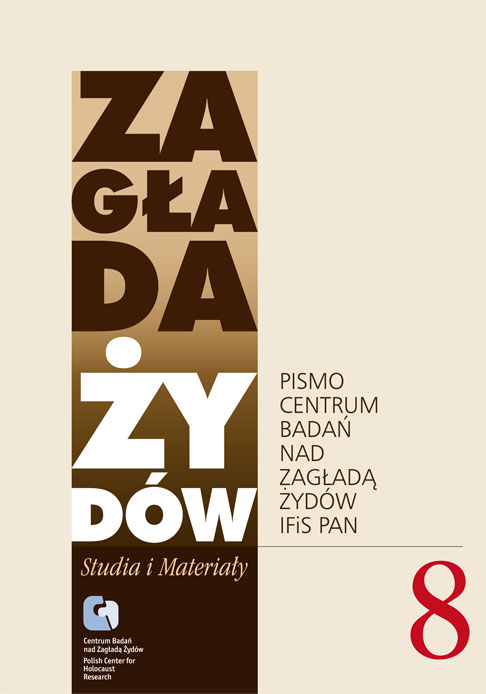Pogłoski w białostockim getcie. Przyczynek do historiografii Zagłady z perspektywy żydowskiej
Zagłada Żydów. Studia i Materiały, Nr 8 (2012), Strony: 214-236
Data zgłoszenia: 2020-10-28Data publikacji: 2012-12-02
 https://doi.org/10.32927/ZZSiM.633
https://doi.org/10.32927/ZZSiM.633
Abstrakt
The article deals with rumors, which were circulated in the Białystok ghetto. It seems that a rumor is a form of collective interpretation of reality whose function is to structure equivocal situations by explaining events or predicting them. The mood and behavior of individuals and groups may be influenced by rumors, in particular if they find themselves – as the Jews in the ghettos – in an exceptional and lifethreatening situation characterized by insecurity, isolation and uncertainty. The article analyzes rumors relating to the deportations of Jews from the ghetto and German mass murder actions. It addresses the following questions: Which impact did the different rumors have? How did the Judenrat and the ghetto population react to them? The article demonstrates that Jews acted upon their apprehension or misapprehension of events and that their subjective evaluation of the German extermination policy influenced their behavior and decisions
Słowa kluczowe
pogłoski , deportacje , niemiecka polityka eksterminacyjna , Judenrat , żydowska perspektywa i zachowania
Licencja
Prawa autorskie (c) 2012 Autor&"Zagłada Żydów. Studia i Materiały"

Utwór dostępny jest na licencji Creative Commons Uznanie autorstwa 4.0 Międzynarodowe.
https://creativecommons.org/licenses/by/4.0
Czasopismo publikowane jest w standardzie Diamond Open Access na licencji CC-BY-4.0 Deed - Uznanie autorstwa 4.0 Międzynarodowa - Creative Commons
Podobne artykuły
- Ewa Wiatr, Wokół jednego listu. Losy wiedeńskich chrześcijan w getcie łódzkim , Zagłada Żydów. Studia i Materiały: Nr 15 (2019)
- Marcin Zaremba, „Ta cała banda żydowska zdechła nareszcie”. Eksterminacja Żydów w listach żołnierzy niemieckich z 1942 r. , Zagłada Żydów. Studia i Materiały: Nr 10 (2014)
- Piotr Rypson, Album rysunków Teofili Langnas-Reich w Archiwum Ringelbluma , Zagłada Żydów. Studia i Materiały: Nr 18 (2022)
- Dariusz Libionka, W poszukiwaniu miliona Sprawiedliwych , Zagłada Żydów. Studia i Materiały: Nr 11 (2015)
- Christoph Dieckmann, Niemiecka polityka okupacyjna na Litwie w latach 1941–1944. Podsumowanie , Zagłada Żydów. Studia i Materiały: Nr 13 (2017)
- Ewa Wiatr, Ruch hachszarowy w getcie łódzkim 1940–1941 w świetle dokumentów. , Zagłada Żydów. Studia i Materiały: Nr 16 (2020)
- Martyna Grądzka-Rejak, Zoë Waxman, Kobiety Holocaustu , Zagłada Żydów. Studia i Materiały: Nr 16 (2020)
- Katarzyna Odrzywołek, Piotr Trojański, Dzieci Teheranu – od mrozów Syberii do słońca Palestyny. Rola delegatur Ambasady RP w ZSRR i Armii gen. Andersa w ratowaniu dzieci żydowskich , Zagłada Żydów. Studia i Materiały: Nr 11 (2015)
- Katrin Stoll, Rozkład jazdy tylko w jedną stronę. Przesłuchania byłych urzędników Reichsbahn na temat deportacji Żydów z Prużan do Auschwitz w 1943 r. , Zagłada Żydów. Studia i Materiały: Nr 12 (2016)
- Marek Kornat, Papież Pius XII i jego koncepcja „neutralności absolutnej” Stolicy Apostolskiej w stosunkach międzynarodowych (1939—1945). Przypadek Polski , Zagłada Żydów. Studia i Materiały: Nr 5 (2009)
<< < 1 2 3 4 5 6 7 8 9 10 11 12 13 14 15 16 17 18 19 20 21 22 23 24 25 26 > >>
Możesz również Rozpocznij zaawansowane wyszukiwanie podobieństw dla tego artykułu.
 English
English
 Język Polski
Język Polski




